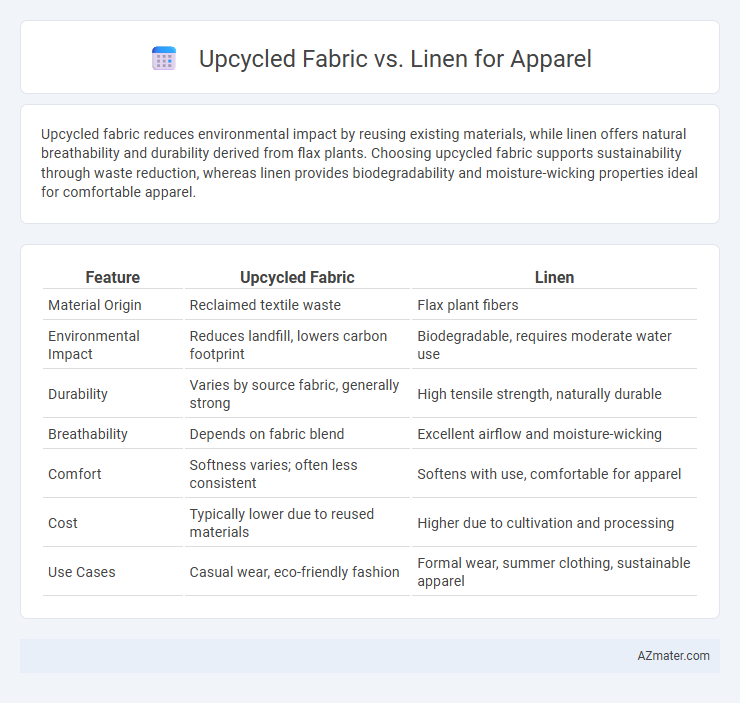Upcycled fabric reduces environmental impact by reusing existing materials, while linen offers natural breathability and durability derived from flax plants. Choosing upcycled fabric supports sustainability through waste reduction, whereas linen provides biodegradability and moisture-wicking properties ideal for comfortable apparel.
Table of Comparison
| Feature | Upcycled Fabric | Linen |
|---|---|---|
| Material Origin | Reclaimed textile waste | Flax plant fibers |
| Environmental Impact | Reduces landfill, lowers carbon footprint | Biodegradable, requires moderate water use |
| Durability | Varies by source fabric, generally strong | High tensile strength, naturally durable |
| Breathability | Depends on fabric blend | Excellent airflow and moisture-wicking |
| Comfort | Softness varies; often less consistent | Softens with use, comfortable for apparel |
| Cost | Typically lower due to reused materials | Higher due to cultivation and processing |
| Use Cases | Casual wear, eco-friendly fashion | Formal wear, summer clothing, sustainable apparel |
Introduction to Sustainable Fabrics in Fashion
Upcycled fabric and linen represent key sustainable choices in fashion, each contributing to eco-friendly apparel production through distinct means. Upcycled fabric reduces waste by repurposing existing textiles, minimizing environmental impact, while linen, derived from flax plants, offers biodegradability and low water consumption during cultivation. Both materials address sustainability by promoting resource efficiency and reducing the carbon footprint of clothing manufacturing.
What is Upcycled Fabric?
Upcycled fabric refers to textile material created by repurposing old or discarded fabrics, reducing waste and environmental impact in the apparel industry. Unlike linen, which is a natural fiber derived from the flax plant known for its breathability and durability, upcycled fabric emphasizes sustainability by extending the lifecycle of existing textiles. This process supports eco-friendly fashion by minimizing resource consumption and promoting circular economy principles in clothing production.
Understanding Linen: Origins and Properties
Linen, derived from the flax plant (Linum usitatissimum), has been used for centuries due to its natural strength, breathability, and moisture-wicking properties ideal for apparel. Its fibers produce a lightweight, durable, and hypoallergenic fabric that excels in warm climates and offers exceptional comfort. Understanding linen's origins helps appreciate its sustainability, as it requires fewer pesticides and water compared to cotton, making it an eco-friendly option for clothing.
Environmental Impact: Upcycled Fabric vs Linen
Upcycled fabric significantly reduces textile waste by repurposing discarded materials, minimizing landfill contribution and lowering carbon emissions compared to virgin textiles. Linen, derived from flax plants, offers a sustainable option due to its low water and pesticide requirements and its biodegradable nature, resulting in a smaller environmental footprint than conventional cotton. Choosing upcycled fabric or linen supports circular fashion efforts and promotes resource efficiency in apparel production.
Durability and Longevity in Apparel
Upcycled fabric offers enhanced durability by repurposing high-quality textiles that have already undergone wear testing, making it a sustainable yet robust choice for apparel. Linen, derived from flax fibers, is naturally strong and breathable but may develop wear patterns and shrinkage over time without proper care. Both materials provide longevity, with upcycled fabric excelling in environmental impact and linen delivering timeless strength and comfort in clothing applications.
Comfort and Wearability for Everyday Use
Upcycled fabric offers sustainable comfort by repurposing soft, breathable materials that adapt well to daily wear, reducing environmental impact without sacrificing softness. Linen, made from flax fibers, provides exceptional breathability and moisture-wicking properties, making it ideal for hot climates and everyday comfort. Both fabrics offer durability, but linen tends to soften with use, enhancing its wearability over time, while upcycled fabrics vary based on the original textile composition.
Style Versatility and Aesthetic Appeal
Upcycled fabric offers unique, eco-friendly style versatility by incorporating diverse textures and patterns that create one-of-a-kind apparel pieces appealing to sustainable fashion enthusiasts. Linen, known for its natural breathability and timeless elegance, provides a classic aesthetic with a crisp, textured finish ideal for both casual and formal wear. Both materials cater to distinct fashion sensibilities, with upcycled fabric emphasizing individuality and environmental consciousness, while linen delivers enduring sophistication and comfort.
Cost Comparison: Upcycled Fabrics vs Linen
Upcycled fabrics generally offer a more cost-effective option for apparel production compared to linen, as they utilize recycled materials that reduce raw material expenses and waste management costs. Linen, derived from flax plants, tends to have higher production costs due to intensive cultivation, processing methods, and quality requirements. The price difference between upcycled fabrics and linen is significant, making upcycled materials an attractive choice for sustainable fashion brands aiming to minimize costs without compromising environmental impact.
Ethical Considerations in Fabric Choices
Upcycled fabric significantly reduces environmental impact by repurposing existing materials, minimizing textile waste, and conserving natural resources compared to linen, which requires extensive water and land for cultivation. Linen offers biodegradability and durability, but its production often involves pesticide use and high water consumption, raising ethical concerns in sustainable apparel. Choosing upcycled fabrics supports circular fashion principles, promoting ethical manufacturing and reducing the carbon footprint associated with new fiber production.
Which Is Better for Apparel: Upcycled Fabric or Linen?
Upcycled fabric offers sustainability advantages by reducing textile waste and lowering environmental impact, making it an eco-conscious choice for apparel production. Linen, derived from flax plants, is prized for its breathability, durability, and natural moisture-wicking properties, ideal for warm-weather clothing. Choosing between upcycled fabric and linen depends on priorities: sustainability and uniqueness favor upcycled materials, while comfort and natural fiber benefits highlight linen's appeal.

Infographic: Upcycled fabric vs Linen for Apparel
 azmater.com
azmater.com